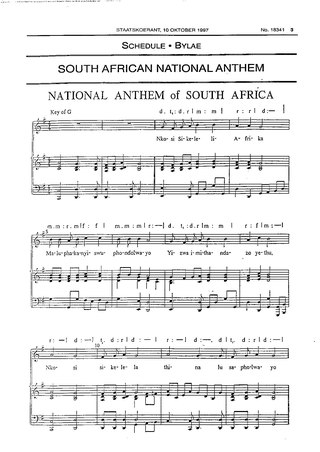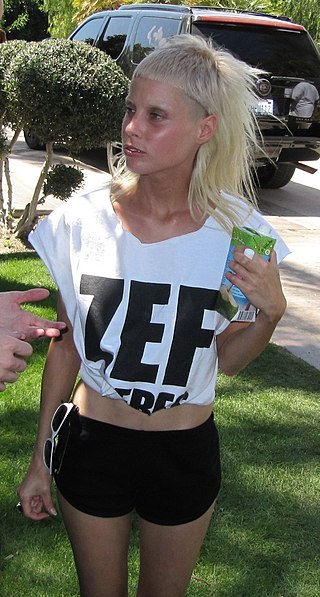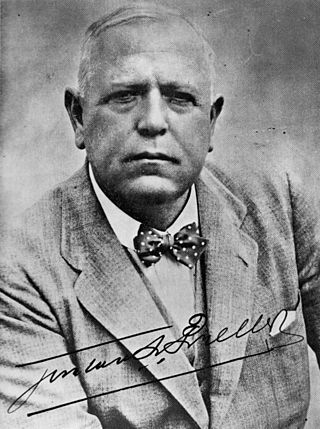Related Research Articles

Boers are the descendants of the proto Afrikaans-speaking Free Burghers of the eastern Cape frontier in Southern Africa during the 17th, 18th, and 19th centuries. From 1652 to 1795, the Dutch East India Company controlled Dutch Cape Colony, but the United Kingdom incorporated it into the British Empire in 1806. The name of the group is derived from Trekboer then later "boer", which means "farmer" in Dutch and Afrikaans.

The national anthem of South Africa was adopted in 1997 and is a hybrid song combining extracts of the 19th century Xhosa hymn "Nkosi Sikelel' iAfrika" and the Afrikaans song that was used as the South African national anthem during the apartheid era, "Die Stem van Suid-Afrika", with new English lyrics.

The Great Trek was a northward migration of Dutch-speaking settlers who travelled by wagon trains from the Cape Colony into the interior of modern South Africa from 1836 onwards, seeking to live beyond the Cape's British colonial administration. The Great Trek resulted from the culmination of tensions between rural descendants of the Cape's original European settlers, known collectively as Boers, and the British. It was also reflective of an increasingly common trend among individual Boer communities to pursue an isolationist and semi-nomadic lifestyle away from the developing administrative complexities in Cape Town. Boers who took part in the Great Trek identified themselves as voortrekkers, meaning "pioneers" or "pathfinders" in Dutch and Afrikaans.

Hendrik Frensch Verwoerd, also known as H. F. Verwoerd, was a Dutch-born South African politician, scholar in applied psychology, philosophy, and sociology, and newspaper editor who was Prime Minister of South Africa. He is commonly regarded as the architect of apartheid and nicknamed the "father of apartheid". Verwoerd played a significant role in socially engineering apartheid, the country's system of institutionalized racial segregation and white supremacy, and implementing its policies, as Minister of Native Affairs (1950–1958) and then as prime minister (1958–1966). Furthermore, Verwoerd played a vital role in helping the far-right National Party come to power in 1948, serving as their political strategist and propagandist, becoming party leader upon his premiership. He was the Union of South Africa's last prime minister, from 1958 to 1961, when he proclaimed the founding of the Republic of South Africa, remaining its prime minister until his assassination in 1966.

The National Party, also known as the Nationalist Party, was a political party in South Africa from 1914 to 1997, which was responsible for the implementation of apartheid rule. The party was an Afrikaner ethnic nationalist party, which initially promoted the interests of Afrikaners but later became a stalwart promoter and enactor of white supremacy, for which it is best known. It first became the governing party of the country in 1924. It merged with its rival, the SAP, during the Great Depression, and a splinter faction became the official opposition during World War II and returned to power. With the National Party governing South Africa from 4 June 1948 until 9 May 1994, the country for the bulk of this time was only a de jure or partial democracy, as from 1958 onwards non-white people were barred from voting. In 1990, it began to style itself as simply a South African civic nationalist party, and after the fall of apartheid in 1994, attempted to become a moderate conservative one. The party's reputation was damaged irreparably by perpetrating apartheid, and it rebranded itself as the New National Party in 1997 before eventually dissolving in 2005.

The Afrikaner Broederbond (AB) or simply the Broederbond was an exclusively Afrikaner Calvinist and male secret society in South Africa dedicated to the advancement of the Afrikaner people. It was founded by H. J. Klopper, H. W. van der Merwe, D. H. C. du Plessis and the Rev. Jozua Naudé in 1918 as Jong Zuid Afrika until 1920, when it was renamed the Broederbond. Its influence within South African political and social life came to a climax with the 1948-1994 rule of the white supremacist National Party and its policy of apartheid, which was largely developed and implemented by Broederbond members. Between 1948 and 1994, many prominent figures of Afrikaner political, cultural, and religious life, including every leader of the South African government, were members of the Afrikaner Broederbond.
Orkney Snork Nie was a popular Afrikaans sitcom, originally broadcast by the SABC in South Africa between 1989 and 1992. The name translates directly into Orkney Doesn't Snore, but the message being conveyed in Afrikaans is that the town isn't sleepy, there's always something happening. The series was written and directed by Willie Esterhuizen who was also involved in other popular South African series and movies. The series consists of four seasons, with two movies also produced. As of 2006, the series was rebroadcast on the Afrikaans DStv channel KykNet.

Zef is a South African counter-culture movement. Kyle Hans Brockmann has compared zef counter-culture to many similar anarchic sub-cultures in the northern hemisphere.

A Volkstaat, also called a Boerestaat, is a proposed White homeland for Afrikaners within the borders of South Africa, most commonly proposed as a fully independent Boer/Afrikaner nation. The proposed state would exclude Afrikaans-speaking Coloureds but accept South Africans of English ancestry and other White South Africans, if they accept Afrikaner culture and customs.

The Voortrekkers is an Afrikaner youth organisation, founded in South Africa in 1931, for Afrikaner boys and girls. It tries to develop resilience, service, leadership and a good character through team meetings, skills development and camping in nature, with the opportunity for whole families to get involved. The movement, which also took off in Namibia, is based on Christian national principles.

The Day of the Vow is a religious public holiday in South Africa. It is an important day for Afrikaners, originating from the Battle of Blood River on 16 December 1838, before which about 400 Voortrekkers made a promise to God that if he rescued them out of the hands of the approximately 20,000 Zulu warriors they were facing, they would honour that day as a sabbath day in remembrance of what God did for them.
Afrikaner nationalism is an ethnic nationalistic political ideology created by Afrikaners residing in Southern Africa during the Victorian era. The ideology was developed in response to the significant events in Afrikaner history such as the Great Trek, the First and Second Boer Wars and the resulting anti-British sentiment and Anti-communism that developed among Afrikaners and opposition to South Africa's entry into World War I.

Gustav Schoeman Preller was a journalist, historian, writer and literary critic. He fought for the recognition of Afrikaans. Preller helped the Afrikaner to realize the importance of the history of South Africa. He made great contributions to the writing of South African history, through his research and literature. He also contributed greatly to making South Africans aware of the legacy of the Voortrekkers and also played an early part in planning the Voortrekker Monument.

Many people of European heritage in South Africa are descended from Huguenots. Most of these originally settled in the Cape Colony, but were absorbed into the Afrikaner and Afrikaans-speaking population, because they had religious similarities to the Dutch colonists.
The Sestigers (Sixtiers), also known as the Beweging van Sestig, were a dissident literary movement of Afrikaans-language poets and writers in South Africa under apartheid. The movement was started in the beachside Cape Town suburb of Clifton during the early 1960s by André Brink and Breyten Breytenbach, under the mentorship of Uys Krige and Jack Cope, and in continuation of a tradition in South African literature pioneered in the 1920s by Roy Campbell, William Plomer, and Laurens van der Post.
Afrikaners are a Southern African ethnic group descended from predominantly Dutch settlers first arriving at the Cape of Good Hope in 1652. Until 1994, they dominated South Africa's politics as well as the country's commercial agricultural sector.

The Afrikaans Language and Culture Association, ATKV, is a society that aims to promote the Afrikaans language and culture. The association was founded in 1930 in Cape Town. Since its inception and up to the end of Apartheid in 1994, membership was only open to members of the Afrikaner Christian community. Membership was thereafter opened to include people of all ethnicities, sharing the same values as the ATKV.
AfriForum is a South African non-governmental organisation which mainly focuses on the interests of Afrikaners, a subgroup of the country's white population. AfriForum has been described as a "white nationalist, alt-right, and Afrikaner nationalist group", though this description is rejected by the organisation's leadership, who refer to themselves as a civil rights group.
The Voëlvry movement in South Africa was a genre of anti-apartheid music sung in Afrikaans. The term Voëlvry means both "free as a bird" and "outlaw". This movement has been said to have started on April 4, 1989 in Johannesburg in a packed club. This marked the beginning of what some have called a rock and roll uprising. The Voëlvry movement used music in the Afrikaans language to show pride. The movement focused on Afrikaner youth. The main goal of the movement was to get Afrikaner youth to see the changes that had to occur in the “authoritarian, patriarchal culture”.
The Dakar Conference was a historic conference between members of the Institute for Democratic Alternatives in South Africa (IDASA) and the African National Congress (ANC). It was held in Dakar, Senegal between 9 and 12 July 1987. The conference discussed topics such as strategies for bringing fundamental change in South Africa, national unity, structures of the government and the future of the economy in a free South Africa. The IDASA delegation from South Africa, participated in the conference in their private capacity and would later be condemned by the South African government for meeting a banned organization. The future indirect result of the conference was South African government talks with Nelson Mandela and his eventual meeting with P. W. Botha in 1989.
References
- ↑ Peffer, John (2005). "Censorship and Iconoclasm: Unsettling Moments". RES: Anthropology and Aesthetics. 48 (48): 52. doi:10.1086/RESv48n1ms20167676. JSTOR 20167676. S2CID 193679336.
- 1 2 Coombes, Annie (2003). History After Apartheid: Visual Culture and Public Memory in a Democratic South Africa. United States of America: Annie Coobes. p. 40.
- 1 2 Peffer, John (2005). "Censorship and Iconoclasm: Unsettling Moments". RES: Anthropology and Aesthetics. 48 (48): 54. doi:10.1086/RESv48n1ms20167676. JSTOR 20167676. S2CID 193679336.
- 1 2 3 4 5 6 Peffer, John (2005). "Censorship and Iconoclasm: Unsettling Moments". RES: Anthropology and Aesthetics. 48 (48): 53. doi:10.1086/RESv48n1ms20167676. JSTOR 20167676. S2CID 193679336.
- ↑ Marnell Kirsten (April 2014). "Alternative to What?: The Rise of Loslyf Magazine". Stellenbosch University. Retrieved 7 January 2017.
- ↑ Coombes, Annie (2003). History After Apartheid: Visual Culture and Public Memory in a Democratic South Africa. United States of America: Annie Coobes. p. 39.
- ↑ Coombes, Annie (2003). History After Apartheid: Visual Culture and Public Memory in a Democratic South Africa. United States of America: Annie Coobes. p. 41.
- 1 2 van Noort, Elvira (1 September 2005). "'Men Can't Write About Blowjobs'". Mail & Guardian. Retrieved 20 March 2011.
- ↑ Prins, Gavin (3 July 2007). "New Loslyf Editor Bares All". News 24. Retrieved 20 March 2011.
- ↑ "Loslyf.co.za".
- ↑ Venter, Zelda. "Adult magazine to fork out again". IOL News. Retrieved 10 May 2011.
- ↑ Venter, Zelda (18 November 2005). "Amor Claims R1m from Loslyf". IOL News. Retrieved 3 April 2011.
- ↑ Nel, Jaco (4 April 2005). "Loslyf Reader Thrown Off Plane". News 24. Retrieved 18 March 2011.